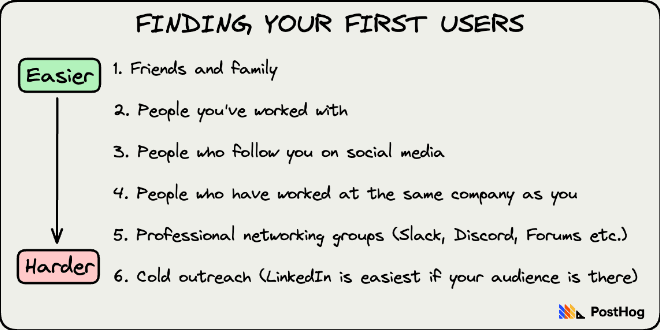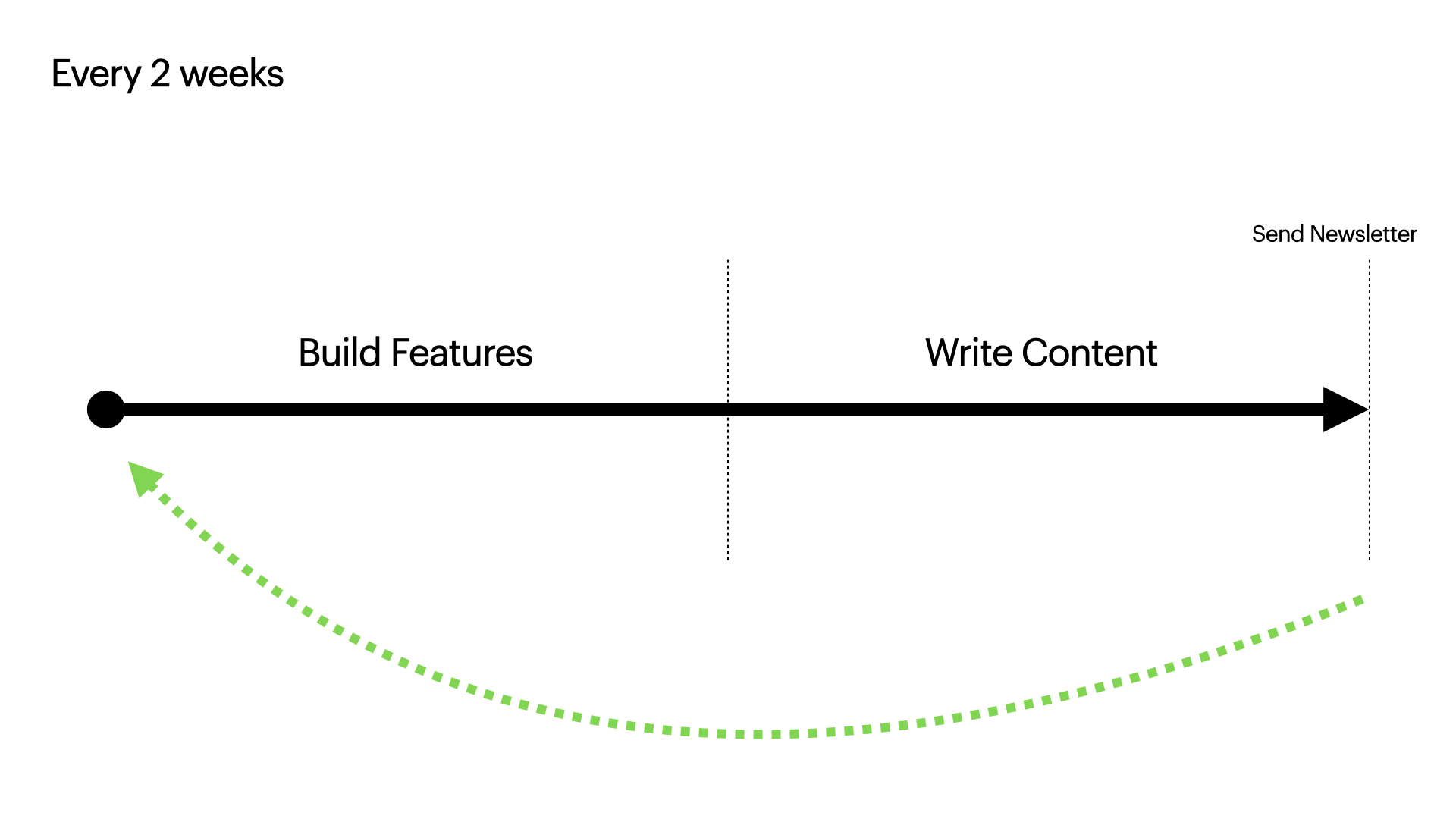Marketing for programmer
As a programmer who loves the building process, I’ve often struggled with marketing my own side ventures. That’s why I decided to compile my thoughts, reflections, and insights from others that I like into these marketing notes for myself.
The hard truth is, marketing is a necessity. Getting your product noticed and attracting your first users. I know by heart how challenging it can be for us as programmers to switch gears from coding to marketing. But just like in the insightful book It Doesn’t Have to Be Crazy at Work by Jason Fried, David Heinemeier Hansson from 37signals, I believe that marketing doesn’t have to be crazy for us.
Notes
Dear Self,
I created this marketing guide as a handy reference for you. Keep it close, and use it whenever you need to do marketing.
Remember, the goal of marketing is to make you or your product get noticed.
Table of Contents
- Principles
- Crafting compelling content
- Finding your first users
- Pulling users in, not pushing them away
- Build a personal brand on a social platform
- Consistency beats hacks \& trends
- Marketing Week
- Don’t follow the crowd
- Have fun
Principles
Marketing can take many forms, including promotions, direct communications, advertising, product positioning, placement, and distribution choices.
As a non-marketing expert, it’s important to stick to your principles and avoid activities you don’t want to spend time on.
- Don’t publish content you wouldn’t share yourself
- Don’t make claims that are not entirely true and verifiable
- Avoid making speculative claims about potential future updates
- Don’t neglect the core product for marketing
- Don’t bombard customers with deals, pop-ups, and other dark patterns. These devalue our product in the long run
- Don’t criticize your competitors
- Don’t make false claims about your competitors
Back in time, you realized the importance of committing to strategies you could maintain over an extended period of time. Marketing is a marathon, not a sprint. Also an experiment game. So, focus on sustainable tactics that you can consistently execute for the long haul.
For instance, with your Twitter channel, you only managed to keep it up for a few weeks and made just a handful of posts. You found it super challenging to come up with ideas for posts, and it honestly wasn’t enjoyable at the end. That experience taught you the value of finding marketing methods that align with your interests and strengths.
Crafting compelling content
- One great article is worth more than 25 mediocre ones
- SEO keywords are not enough if the content isn’t helpful
- Content is the foundation for building lasting relationships
Competing with larger companies based on the amount of content you produce is a losing battle. Instead, concentrate on creating high-quality content. Right now, you’re not Zappier, and that’s okay. Remember, one great article is worth more than 25 mediocre ones. Quality content performs better over time, especially when it comes to SEO. Think of your writing like a venture capitalist thinks about investments: spend time updating and improving your best pieces.
Always ask yourself: “Is this content genuinely useful to the target audience?” This question applies to everything you write, including SEO articles. Good keywords are not enough if the content isn’t helpful. People are overwhelmed with information and don’t have time for fluff.
Remember, content is not just a marketing tool, it’s the foundation for building lasting relationships.
Finding your first users

- Just know who your users are
- You don’t need an in-depth plan
- Be prepared to try different channels
- When you reach out, keep your message short
- Be direct about your intentions
Before you start your search, make sure you have a plan for finding your initial users. You don’t need an exhaustive plan, but it’s important to have a clear idea of who your users are and how to reach them. Be prepared to explore multiple channels, as not every approach will work. When you reach out, keep your requests short and to the point. Aim for two or three sentences, not a wall of text. Be direct about your intentions; clearly state if you’re seeking feedback or if you’re looking to sell. Remember, having a deadline helps. It gives you a reason to push yourself. Without that deadline, it’s easy to lose your focus, and as you know, finding those first users can be tough.
Pulling users in, not pushing them away
Customers will evaluate you first and foremost based on your product. Pushing customers into using your product won’t lead to long-term success.
If a customer doesn’t choose your product, that means either:
- The product isn’t good enough
- The product isn’t the right solution for them
- You didn’t communicate the benefits of the product well enough
Don’t fall into the trap of thinking that companies will keep long-term customers just because they spam them with generic content. Don’t forget that lasting relationships are built on genuine value and meaningful engagement.
Build a personal brand on a social platform
These days, people buy from people they relate to, trust, and like. As a one-person business owner, your personal brand is a powerful asset that can help you connect with your target audience, establish credibility, and drive business growth. One of the most effective ways to build your personal brand is by showing up and posting content online. Remember, building a personal brand takes time and consistency. So don’t get discouraged if you’re not seeing traction right away. Let your personality shine through in your online presence. It’s much easier for people to relate to you if they feel like they’re getting to know the real you.
Consistency beats hacks & trends
Start with the handful of channels that you personally use and understand. If you’re a Twitter person but rarely use Facebook and can’t comprehend the interest of Pinterest, then spend a few months trying to build a corporate Twitter presence and buy Twitter ads. So, stay with what you know, where you’re comfortable, and focus on doubling your business on that channel. Sometimes, getting outside your comfort zone is wrong. Spreading yourself thin is even more wrong. Don’t treat it like an assembly line you’re pushing content through in exchange for likes. Instead, treat it like you’re talking to a bunch of human beings you care about and who you genuinely want to help.
As a huge bonus: you’ll be less worn out because you’re focused on just one social network and just one group of friends. It’s much less overwhelming that way.
Marketing Week

Think back to when you discovered John Yongfook from Bannerbear and his innovative approach to balancing coding and marketing. Just like you, John is a technical person who loves the building process more than marketing and promoting the product.
He divides his time into two-week cycles, and it’s a nice routine to follow as a programmer:
Week 1: Focus solely on coding and building features for your product.
Week 2: Transition to marketing—promote your work, share insights, and engage in any activity that relates to marketing.
During marketing week, John suggests considering the following activities:
- Tweet something of interest to your target market.
- Participate in forums where your customers are active.
- Improve your marketing site and documentation.
- Create a free tool that complements your app.
- Write a blog post aimed at your target audience.
- Write a weekly or monthly newsletter with tips and advice.
Remember, the more complicated you make it, the harder it becomes to stick to your routine. So keep it straightforward: one week for coding and one week for marketing.
Do you remember, you’ve tried this approach before and gained some small victories with one of your early products?
Don’t follow the crowd
When you write, sound, or act like everyone else, you send a clear message: “Our products are just like everyone else’s.” You know this feeling well—most corporate websites and brochures simply don’t leave a lasting impression. Consider the overused phrases that dominate the landscape, such as “effective end-to-end solutions,” “provider of value-added services,” and “full-service solutions provider.” They lack authenticity and fail to inspire.
It’s easy to get swept up in buzzwords, especially when marketers and sales professionals throw around terms like “2x-ing” or “10x-ing” your revenue. But here’s the truth: there’s real power in honesty. Instead of grand claims, sometimes it’s more effective to say, “I can probably help you grow by 3-5%.”
So, embrace what makes you unique. Ditch the bland jargon and focus on clear, genuine communication. Your authenticity will resonate more with your audience and set you apart from the crowd.
Have fun
My final tip is to have fun with this journey.
Seriously, there’s no point in doing something if you don’t like it.
It’s about the experiences and the learning, not just results.
Have fun!